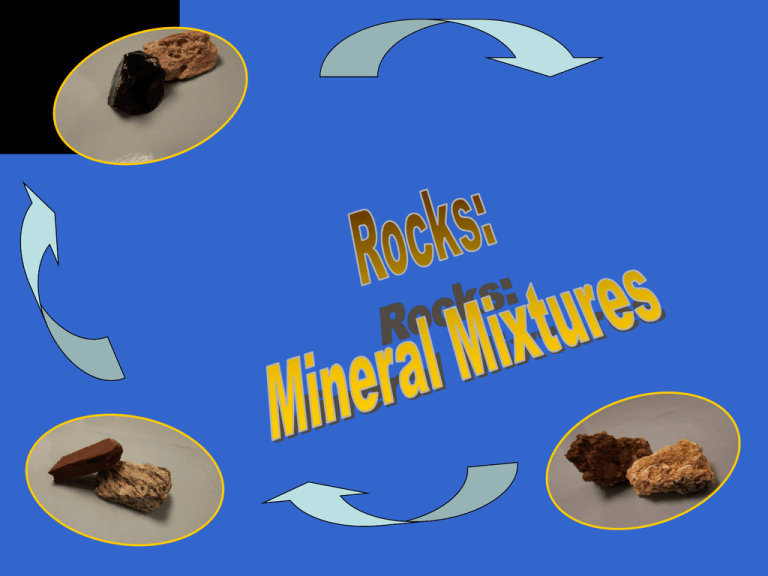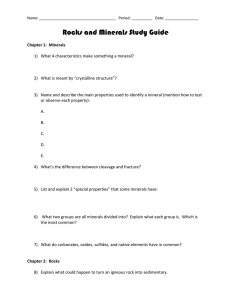rocks notes
advertisement

All rocks are heavy. True or False A heavy piece of rock? Think again! All rocks are hard. True or False False • Chalk • Pumice • Talc Rocks never change. True or False False • Rocks are changed by processes such as: – Melting – Pressure – Heat – Weathering and Erosion Minerals • A mineral is a naturally formed solid that has a repeating threedimensional structure. • Minerals are the building blocks that make up rocks. By asking the four questions you can tell if something is a mineral. 1. Is it nonliving material? A mineral is inorganic, meaning it isn’t made of or by living things. 2. Is it formed in nature? Crystalline materials made by people aren’t classified as minerals. Minerals are not formed by plants or animals. 3. Is it a solid? Minerals can’t be gases or liquids. 4. Does it have a crystalline structure? Minerals are crystals, which have a repeating inner structure that determines the shape of the crystal. If you cannot answer “yes” to all four questions, you don’t have a mineral. • A crystal is a solid substance in which the atoms are arranged in a repeating pattern in three dimensions. • Each mineral has a crystalline structure that depends on the elements that make up the mineral. The arrangement of the atoms within the crystal creates the crystal’s shape. Types of Minerals Minerals are divided into two groups based on the elements they are made of: 1 Minerals that contain the elements silicon and oxygen are called silicate minerals. 2 The nonsilicate minerals do not contain a combination of the elements silicon and oxygen. Minerals in this group are made up of other elements, such as carbon, oxygen, iron, and sulfur. Identifying Minerals using 7 physical properties 1. Color - Small amounts of impurities can change a mineral’s color 2. Luster - the way the surface of a mineral reflects light. Minerals have metallic, sub- metallic, or nonmetallic luster. 3. Streak -the color of a mineral in powdered form. When a mineral is rubbed against a hard plate, the mark left behind is the streak. 4. Cleavage and Fracture - is the tendency of some minerals to break along flat surfaces. The way that a mineral breaks is determined by the arrangement of its atoms. 5.Hardness - a mineral’s resistance to being scratched. Scientists use Mohs hardness scale to compare the hardness of minerals. 6.Density - is the measure of how much matter there is in a given amount of space. 7. Special properties • Fluorescence—Calcite and fluorite glow under ultraviolet light. • Chemical reaction—Calcite will “fizz” when a drop of weak acid is placed on it. • Optical properties—A thin, clear piece of calcite placed over an image will cause a double image. • Taste—Halite has a salty taste. • Magnetism—Magnetite and pyrrhotite are both natural magnets that attract iron. • Radioactivity—Minerals that contain radium or uranium can be detected by a Geiger counter. Review questions 1.How do you determine a minerals streak? • By scraping the mineral across a ceramic streak plate. The color of the material that rubs off the mineral sample is the mineral’s streak. 2. What is the difference between cleavage and fracture? If a mineral has cleavage, it breaks along flat surfaces. Fracture is the way a mineral breaks along curved or irregular surfaces See page 397 of text for picture Minerals Combine to Form Rock • Rock is a solid mixture of crystals of one or more minerals. • The main classification of rock depends on how the rock formed. 1. Igneous rock forms when hot, liquid rock, (magma) cools and hardens. 2. Sedimentary rock forms when pieces of rocks or minerals are compacted or cemented together. 3. Metamorphic rock forms when existing rock is heated and squeezed deep inside the Earth. Each of the three types of rock is further classified by composition and texture. • The composition of a rock is its chemical makeup, or the combination of minerals from which the rock is made. • The texture of a rock is determined by the sizes, shapes, and positions of the minerals that the rock contains. – Rock with large crystals or mineral grains has a coarse-grained texture. – Fine-grained texture describes rock with very small or no visible crystals or mineral grains. The Rock Cycle • The rock cycle is the continual process by which new rock is formed from old rock material. Each type of rock can be changed into every other type of rock. Igneous Rock • Igneous rock forms when hot, liquid rock, or magma, cools and hardens. • The type of igneous rock that forms depends on: 1. composition of the magma and 2. the amount of time it takes the magma to cool. Igneous rock starts out as magma. Magma is created in three ways: 1. when rock is heated, 2. when pressure is released, 3. when the composition of the rock changes. Melting 3 ways igneous rock can melt into magma or be created: • Pressure - The high pressure deep inside the Earth forces minerals to stay in the solid state. When hot rock rises to shallow depths, the pressure is released and the rock can melt. • Temperature - A rise in temperature can cause the minerals in a rock to melt. Different melting points cause some of the minerals to melt while other minerals remain solid. • Composition - When fluids such as water combine with rock, the composition of the rock changes, which lowers the melting point of the rock enough for it to melt Igneous rocks are formed when magma cools. • If the magma comes to the surface of the Earth, it is called lava. • Igneous rocks are formed when some of the melted magma rises to a higher level in the mantle of the earth. • The magma’s temperature lowers (cools) and begins to solidify— creating rock. This usually occurs at the edges of tectonic plates. • Igneous rocks also form when parts of the Earth’s crust cave in and melt. • This melted crust returns to the surface, cools and solidifies. • Granite and basalt are common types of igneous rocks. Igneous rocks are broken down into 2 types: 1 – intrusive (plutonic) 2 – extrusive (volcanic) Intrusive Igneous rocks • Intrusive rocks solidify within the crust of the Earth and form great masses of regular crystals. • They are usually hidden because they are formed under the crust. • Uplift and erosion bring these rocks to the Earth’s surface over time, and they become exposed. • When rocks solidify in cracks through which the magma flows, it is called an igneous vein—and both large and small crystals are formed. • A geological process called uplift causes areas of the Earth’s crust to rise to higher elevations. • That means, rocks deep inside the earth can be moved to the surface by motions of the Earth’s crust. When a rock reaches the surface of the Earth, the processes of weathering and erosion begin. Extrusive igneous rocks • Extrusive igneous rocks solidify outside the crust, after volcanic eruptions. • They form with very few crystals. Magma can cool at different rates. The longer it takes for magma or lava to cool, the more time crystals have to grow. The more time crystals have to grow, that coarser the texture of the igneous rock. Sedimentary rocks are formed when layers of earth have been deposited in the bottoms of bodies of water. Over time these layers are pressed together forming sedimentary rocks. Erosion by wind and water on the Earth’s surface break down rocks into small pieces called sediments. These sediments contain organic (carbon based lifeform) remains, and are moved by the wind and water. • In the areas where the fragments are deposited, the sediments cling together, become compacted, and undergo a CHEMICAL CHANGE! • This compaction and chemical change is caused by great pressure, which cements the fragments together and forms sedimentary rock. • Limestone and shale are the most common types of sedimentary rocks. • Sedimentary rocks make up 75% of the rocks on the Earth’s land surfaces. • Sedimentary rocks are classified by their grain size. Metamorphic rocks were once sedimentary or igneous rocks that have been placed under tons of pressure and heat. Metamorphic rocks • Metamorphic rocks have an extremely varied composition. They are formed by the transformation of igneous or sedimentary rock. • This change occurs when either igneous or sedimentary rock masses are subjected to conditions of high pressure and/or temperature. This causes the rock’s structure to CHANGE CHEMICALLY and creates new minerals. Textures of metamorphic rock • All metamorphic rock has one of 2 textures: foliated or non-foliated • Foliation - Metamorphic rock that is foliated contains minerals that are arranged in planes or bands. Rocks that contain a variety of minerals tend to form foliated rocks. • Because minerals are aligned, foliated rocks split into layers. Metamorphic rocks are often classified by their texture (fine, medium or coarse-grained). Textures of metamorphic rock Revisit the Rock Cycle • Over time, all rock is broken down by the forces of wind and water into sediments. This action is called weathering. Weathering • Weathering and erosion are the cause of the production and movement of sediments. • There are 2 types of weathering: – Mechanical – breaks the rocks apart physically without changing the chemical composition of the original rock. (Ex. Ice breaks a rock) – Chemical – changes the chemical composition of the rock (ex. Acid rain eroding rock). • Rocks are continuously changing from one type to another, although very slowly, and this process is called the rock cycle. • As you can see, all the different kinds of rocks are being continuously recycled. No matter how they are formed, eventually they will be broken down by erosive forces. • Much of the sediments formed by the wind and water erosion are deposited into the sea, where new sedimentary rocks will be formed. • The grinding movement of the Earth’s tectonic plates also recycles rocks. Pieces of igneous and seabed sedimentary rock get broken off and are added to the cycle. • These fragments can be dragged downward, where new metamorphic rocks can be formed by heat and pressure. • Then volcanoes can bring them back up to the surface to form igneous rock and eventually start the erosion process all over again. • This cycle has been going on for millions of years. A rock can be a thing of beauty.




